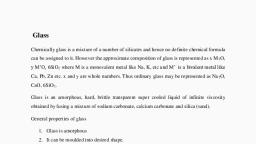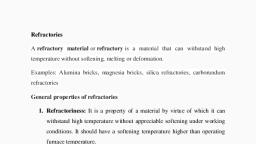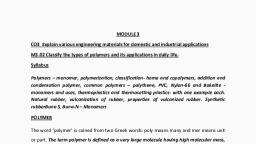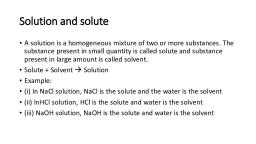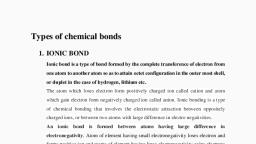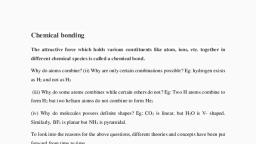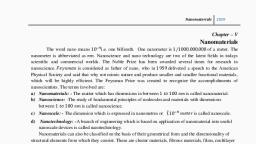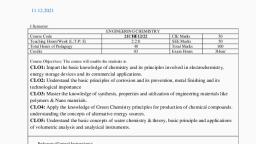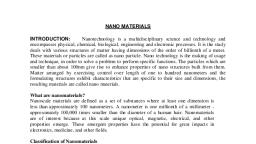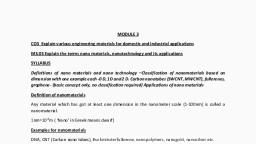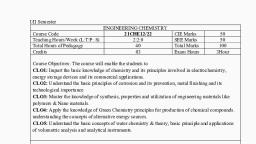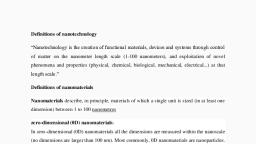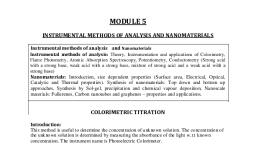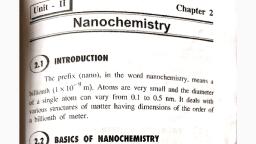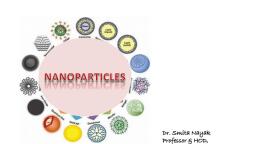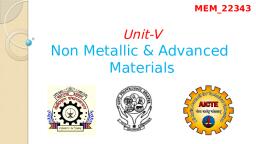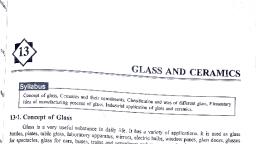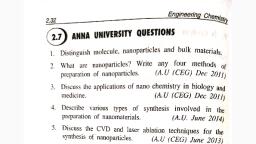Page 1 :
MODULE 3, CO3 Explain various engineering materials for domestic and industrial applications, M3.03 Explain the terms nano materials, nanotechnology and its applications, SYLLABUS, Definitions of nano materials and nano technology –Classification of nanomaterials based on, dimension with one example each -0 D, 1D and 2 D. Carbon nanotubes (SWCNT, MWCNT), fullerenes,, graphene- (basic concept only, no classification required) Applications of nano materials, Definition of nanomaterials, Any material which has got at least one dimension in the nanometer scale (1-100nm) is called a, nanomaterial., 1nm=10-9m ( ‘Nano’ in Greek means dwarf), Examples for nanomaterials, DNA, CNT (Carbon nano tubes), Buckminsterfullerene, nanopolymers, nanogold, nanosilver etc., Nanochemistry, Nanochemistry deals with the synthesis and characterisation of nanomaterials., Definition of nanotechnology, Nanotechnology is the design, characterization, production and application of nanostructures,, devices and systems by controlled manipulation of size and shape at the nanometer scale that, produces at least one novel property or application., OR, Nanotechnology includes the application of nanostructures and nanomaterials into useful nanoscale, devices and components., OR, Nanotechnology deals with the applications of nanomaterials., Father of nano technology - Richard Feynman, Nobel Laureate-1965, The word nanotechnology was coined by Prof. Norio Taniguchi in 1974, Nanotechnology-Key ideas:, 1. The nanometer is extremely small., 2. At the nanometer scale, materials may behave differently., 3. We can use this new behavior to make new technologies., The material properties of nanostructures are different from the bulk due to the high surface area, over volume ratio and possible appearance of quantum effects at the nanoscale., Examples: Materials such as gold, which is chemically inert at normal scales, can serve as a potent, chemical catalyst at nanoscales. Aluminium at nanoscale is highly combustible., Chemistry notes-Govt. Polytechnic College Cherthala
Page 2 :
Classification of nanomaterials based on dimension, Nanomaterials have extremely small size which having at least one dimension in the nanoscale (1100nm). According to Siegel, Nanomaterials are classified as Zero dimensional (0D), one dimensional, (1D), two dimensional (2D) and three dimensional (3D) nanomaterials., Zero-dimensional nanomaterials: In 0D nanomaterials, all dimensions (x, y, z) are in the nanoscale,, i.e., no dimensions are greater than 100 nm., Examples: quantum dots, nanoparticles, fullerenes, clusters, metal nanoparticles, One-dimensional nanomaterials: In 1D nanomaterials, two dimensions are in the nanoscale and one, dimension in the macroscale. This leads to needle shaped nanomaterials., Examples: carbon nanotubes, nanofibres, nanorods, nanowires, Two-dimensional nanomaterials: In 2D nanomaterials, one dimension is in the nanoscale and the, other two are in the macroscale. The 2D nanomaterials exhibit platelike shapes., Examples: nanofilms, graphene, graphene oxide with nanometre thickness., Three-dimensional nanomaterials: In 3D nanomaterials all dimensions are in the macroscale. The bulk, (3D) nanomaterials are composed of a multiple arrangement of nanosize crystals in different, orientations., Examples: graphite, bundles of nanotubes and nanowires, composites, FULLERENES, Fullerenes are allotrope of carbon. They are a class of molecules of carbon having a hollow carbon, cage structure. The most stable form of fullerenes is Buckminster fullerene (C60) with 60 carbon, atoms arranged in a spherical structure. The shape of the molecule, known as truncated icosahedron, which contains 12 pentagons and 20 hexagons. It is a one dimensional (1D) nanomaterial. It was, discovered by Robert Curl, Harold Kroto, and Richard Smalley in 1985 and they won the Nobel Prize in, Chemistry for the discovery of the fullerenes in 1996. The name Buckminsterfullerene was defined to, the C60 molecule in honour of R. Buckminster Fuller, an American architect who designed, geodesic domes with similar structure. Since it resembles a soccer ball, it is also known as bucky ball., , USES, 1. Fullerene and its derivatives have potential antiviral activity and used for the treatment of HIV, infection., 2. They can act as biological anti-oxidants., 3. They are used in targeted drug delivery., 4. Fullerene derivatives are used as catalysts., 5. They are used as lubricants., Chemistry notes-Govt. Polytechnic College Cherthala
Page 3 :
CARBON NANOTUBES, Carbon nanotubes (CNTs) are allotrope of carbon which seems to be formed by rolling a sheet of, graphite (graphene) into cylindrical structure having diameter 1-100nm. CNTs are one dimensional, nanomaterials (1D), two dimensions are in the nanoscale and one dimension is in the macroscale., , Classification of carbon nanotubes, CNTs are generally classified into two, 1. Single walled carbon nanotubes (SWCNTs)-which consist of only one cylinder of carbon, atoms., 2. Multiwalled carbon nanotubes (MWCNTs)- which consist of more than one cylinder of carbon, atoms., , Based on the orientation of lattice CNTs are classified into three., 1. Armchair, 2. Zig-Zag, 3. Chiral, Properties of carbon nanotubes, 1. Carbon nanotubes are very strong., 2. Their tensile strength is 100 times greater than that of steel of the same diameter., 3. Young’s modulus is about 5 times higher than for steel., 4. They have high thermal conductivity-more than 10 times that of silver., 5. They conduct electricity better than metals., 6. They are light weight, density about one fourth of steel., , APPLICATONS OF CARBON NANOTUBES, 1. They are used as the strengtheners of composite materials., 2. They can act as molecular size test tubes for drug delivery., 3. They are used as tips for analysis of DNA and proteins by atomic force microscopy., , Chemistry notes-Govt. Polytechnic College Cherthala
Page 4 :
4. They are used as heat conductors., 5. They are used as a replacement of copper in integrated circuits., 6. They are used in solar cells., 7. CNTs are used as catalysts., 8. CNTs composites are used for aerospace applications., , GRAPHENE, Graphene is a one-atom-thick layer of carbon atoms arranged in a hexagonal lattice. It is a crystalline, allotrope of carbon with 2-dimensional properties(2D nanomaterial). It is one atomic layer of, graphite. Each carbon atom in graphene is covalently bonded to three other carbon atoms with sp2, hybridization. Monolayers of graphene stacked on top of each other form graphite., Well-known forms of carbon-containing molecules that derived from graphene are graphite, fullerene,, and carbon nanotube. Therefore, graphene can be called “the mother” of all these three sp2 carbon, structures. Graphene was first isolated by A.K. Geim and K.S. Novoselov in 2004. They got Nobel Prize, in 2010 for their pioneering work., , PROPERTIES, 1. Graphene is the thinnest known material and in the same time is the strongest material ever, to be measured., 2. High thermal conductivity., 3. High electrical conductivity., 4. High elasticity and flexibility., 5. High hardness., APPLICATIONS, 1., 2., 3., 4., , Used in the manufacture of microchips and transistors, Used in solar panels, Used for anti-corrosion coatings and paints, For making flexible displays, , Chemistry notes-Govt. Polytechnic College Cherthala
Page 5 :
Applications of nanotechnology/ Nanomaterials, 1. Nanomaterials are having high surface area. So they can act as better heterogeneous catalysts, 2. Tumours can be detected with incredible accuracy., 3. Nanoshells can float through the body attaching only to cancer cells. When excited by a, suitable radiation, they give off heat and thereby destroy the tumour., 4. Nanotechnology can deliver right amount of medicine to the exact part of the body., 5. Nanotechnology can create biocompatible joint replacements and artery stents., 6. Nanotechnology is used for DNA mapping., 7. Nanosilver is incorporated into clothing items like socks to prevent odor by killing odorcausing bacteria., 8. Nanotechnology is used to produce water repellent cloths., 9. Nanotechnology is used for miniaturization of electronic devices., 10. Nano ZnO is used in Sunblocks., 11. Carbon nanotubes are used in aerospace industry., 12. Nanotechnology is used to make efficient batteries, solar cells and fuel cells., , Chemistry notes-Govt. Polytechnic College Cherthala
